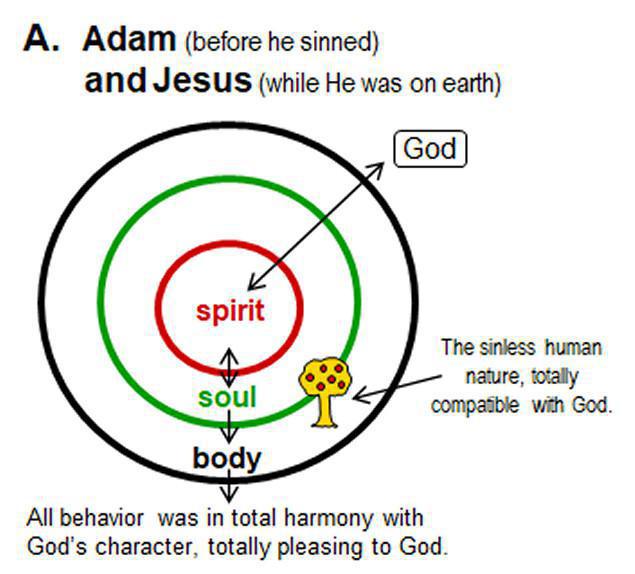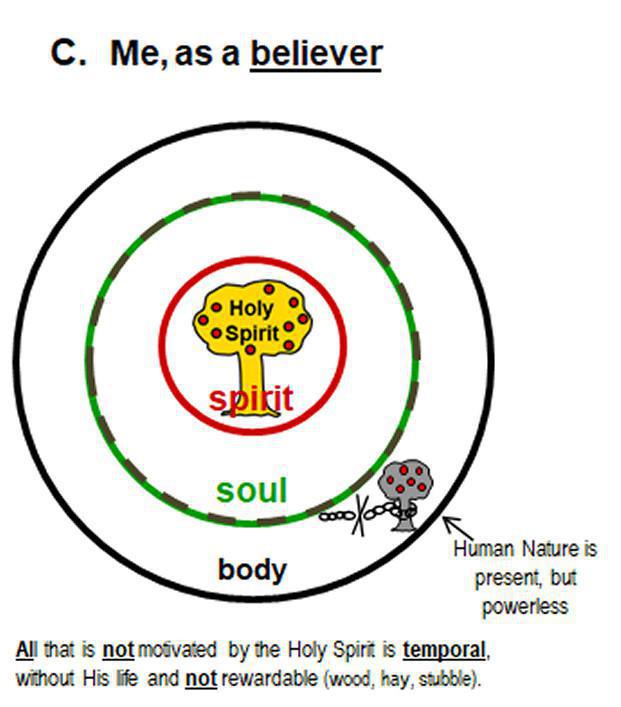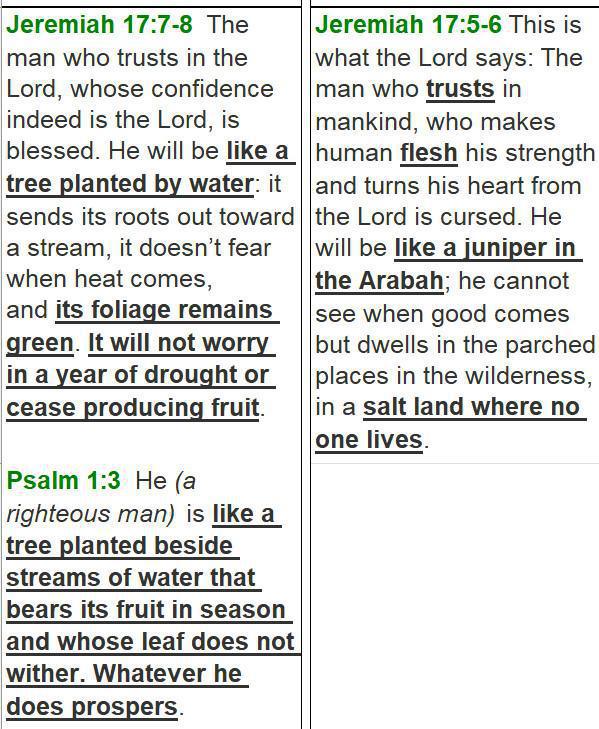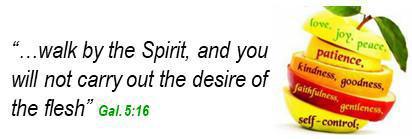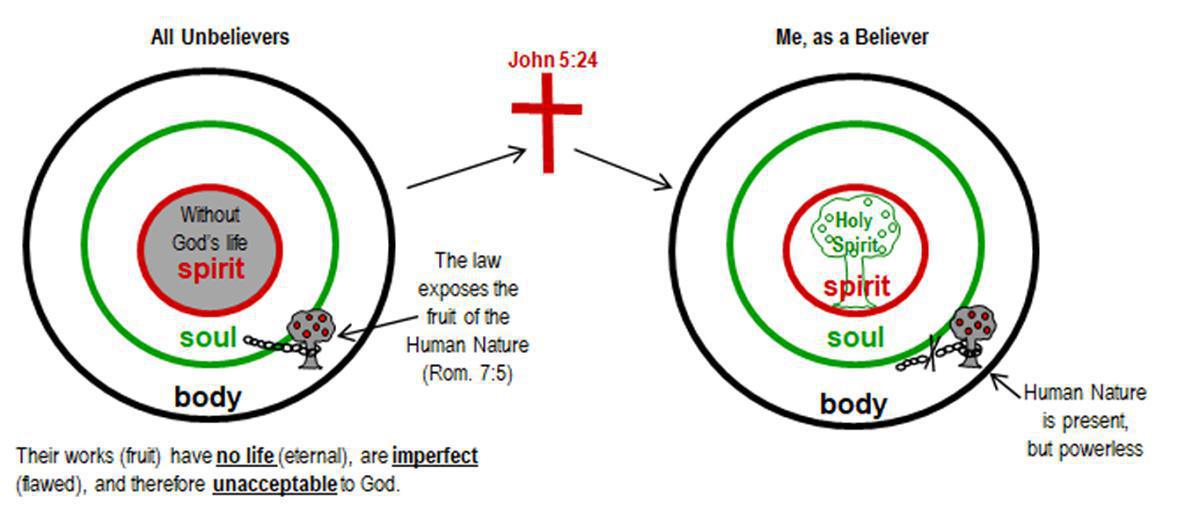This lesson builds on the discussion of my two natures introduced in lesson 1-5.
Understanding how my two natures interact will lay the groundwork for studying abiding in the next several lessons.
1) The following three diagrams depict three spiritual conditions.
Diagram A
Portrays Adam as God intended (before he sinned) and Jesus while He was on earth (never sinned).
Jesus was called the second Adam, because Jesus, a life-giving Spirit, was God’s plan for saving mankind due to Adam’s sin.
1 Corinthians 15:45-49 So it is written: The first man Adam became a living being; the last Adam became a life-giving Spirit. However, the spiritual is not first, but the natural, then the spiritual.
The first man was from the earth and made of dust; the second man is from heaven. Like the man made of dust, so are those who are made of dust; like the heavenly man, so are those who are heavenly. And just as we have borne the image of the man made of dust, we will also bear the image of the heavenly man.
Genesis1:27 So God created man in His own image; …
Genesis 2:7 Then the Lord God … breathed the breath of life into his nostrils, and the man became a living being. (only said of mankind)
Genesis 1:31 God saw all that He had made, and it was very good.… (no imperfections, nothing lacking)
Romans 5:14 … He (Adam) is a prototype of the Coming One.
1 Corinthians 15:45 … The first man Adam became a living being; the last Adam (Jesus) became a life-giving Spirit.
Philippians 2:5-7 … Christ Jesus, … emptied Himself by assuming the form of a slave, taking on the likeness of men.
Hebrews 4:15 (Jesus) ... One who has been tested in every way as we are, yet without sin.
Diagram B
Depicts the unbeliever who was born as a descendent of Adam and is dead spiritually, represented by the dark circle in the middle, indicating the spirit without God.
The dark tree represents the corrupted human nature, and the chain extending from the tree illustrates this person is in bondage to the sinful nature.
As an unbeliever, my sin nature is a barrier that separates me from God. God's purpose for showing us sin is so we recognize it, acknowledge it before Him, and let Him forgive it so that He can make us into the image of His Son. He continually woos and calls the unbeliever to come to Him.
Romans 3:23 For all have sinned and fall short of the glory of God.
Romans 3:10-12 … There is no one righteous, not even one. … there is no one who seeks God. … There is no one who does what is good, not even one.
1 Corinthians 15:22 For as in Adam all die,…
Ephesians 2:12 … without hope and without God in the world.
Thought: God can only accept that which is perfect (100%, without blemish). Nothing that originates from the human nature has that quality. The unbeliever is devoid of God's life. Only God alone can produce anything of eternal value.
Diagram C
Depicts me as a believer who has put my faith in Christ as my Savior, and in that moment the Holy Spirit came into my life and resides in my spirit.
While the Holy Spirit resides in me, so does the sinful nature, which is not improved, changed or renovated and on its own cannot produce fruit that is acceptable and pleasing to God. However, as I walk in the Spirit, I will not carry out the desires of my flesh or sinful human nature.
Galatians 4:6 And because you are sons, God has sent the Spirit of His Son into our hearts…
Galatians 5:16 I say then, walk by the Spirit and you will not carry out the desire of the flesh.
2) God uses trees and plants to contrast the two natures.
3) James compares the human nature to a “salt water” spring and the divine nature of the Holy Spirit to a spring of “living water.”
James 3:9-12 … Praising and cursing come out of the same mouth. My brothers, these things should not be this way. Does a spring pour out sweet and bitter water from the same opening? Can a fig tree produce olives, my brothers, or a grapevine produce figs? Neither can a saltwater spring yield fresh water.
John 7:37-39 … Jesus stood up and cried out, “If anyone is thirsty, he should come to Me and drink! The one who believes in Me, as the Scripture has said, will have streams of living water flow from deep within him.” He said this about the Spirit.…
John 4:13-14 Jesus said, “Everyone who drinks from this water will get thirsty again. But whoever drinks from the water that I will give him will never get thirsty again—ever! In fact, the water I will give him will become a well of water springing up within him for eternal life.”
4) In Romans, Paul contrasts how we were before salvation, and how we are now as believers.
Note: In the following verses, “death” refers to “absence of life”, that is, devoid of life originating from God. (for example, a salt water spring).
a) As an unbeliever I was dominated by my sinful nature, which resides in my physical body.
Romans 7:5 For when we were in the flesh, the sinful passions operated through the law in every part of us and bore fruit for death (absence of life).
b) Now, as a believer, I have been freed from bondage to the sinful nature.
Romans 7:6 But now we have been released from the law, since we have died to what held us, so that we may serve in the new way of the Spirit and not in the old letter of the law.
c) From God’s perspective I have “died to” (been freed from) the sinful nature, and have been joined to Christ.
Romans 6:18, 22 …and having been liberated from sin, you became enslaved to righteousness. … you have been liberated from sin and have become enslaved to God, you have your fruit, which results in sanctification—and the end is eternal life!
Romans 7:4 … you also were put to death in relation to the law through the crucified body of the Messiah, so that you may belong to another—to Him who was raised from the dead—that we may bear fruit for God.
"The fact is, Christians died to sin. The Greek past tense for “died” suggests a specific point when the action occurred, at salvation. Death, whether physical or spiritual, means separation, not extinction (Romans 6:6-7, 14). Death to sin is separation from sin’s power, not the extinction of sin. Being dead to sin means being “set free from sin” (Romans 6:18, 22 above). That being true, Paul asked, “How can they live in it any longer?” Obviously believers cannot live in sin if they died to it.”
Walvoord, John F., and Zuck, Roy B., The Bible Knowledge Commentary, (Wheaton, IL: Scripture Press Pub., Inc.) 1983


